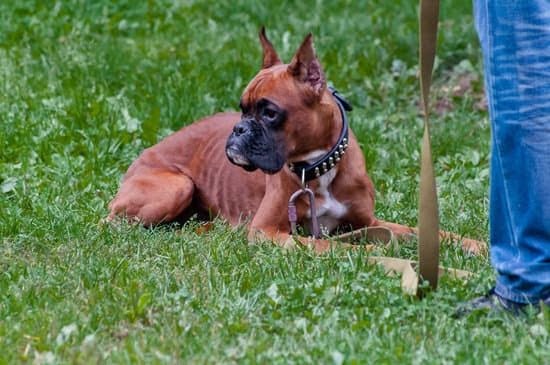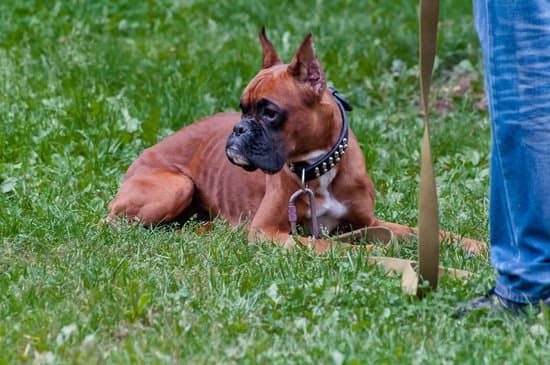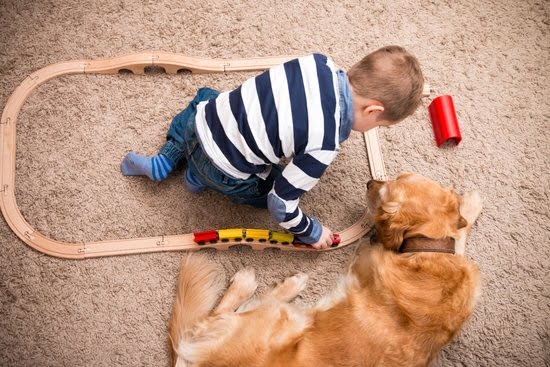Introduction
Dog protection training is an important part of responsible pet ownership. It teaches your dog to be mindful of their environment and gives them the necessary skills to keep themselves and others safe. With proper instruction, a well-trained dog can serve as a trustworthy companion that contributes to the safety of their home, family and community.
This type of training can have many benefits, coming in several forms and varying levels of difficulty. For instance, basic protection training may involve teaching your dog obedience commands such as “sit,” “stay,” “come” or “down.” Teaching a dog these commands helps instill discipline while also creating comfort in following orders. Protection training can also include agility exercises to help develop coordination and speed, which could be an essential skill in an emergency situation where quick action is needed. On a more advanced level, protection training can encompass behaviors involved with searching and pursuing an intruder or reacting appropriately in an unpredictable scenario. Of course there are different levels within each area depending on what level of protection you want from your pet.
No matter the goal of the training, one thing remains constant: successful execution relies heavily on the strength of the bond between owner and pet. Before embarking on any form Protection Training it is highly recommended to strengthen this connection first by building trust through affectionate reinforcement and positive reinforcement rewards such as treats or verbal praise for good behavior. Working together with consistency will ensure better development for both you as the owner as well as your four-legged friend.
Preparing for Training
1. Socialize Your Dog: Before beginning protection training, it is important to socialize your dog. This will enable them to become accustomed to different people, places, and environments, which can help make their protection training more effective.
2. Make sure your dog is familiar with basic commands: It’s also a good idea to make sure that your dog is trained in basic obedience commands before beginning protection training as it will be easier for them to understand the concepts of what is expected from them during protection work. When teaching basic commands, be sure to use positive reinforcement techniques such as verbal praise and treats in order to reward desired behavior and keep the learning process fun for the both of you!
3. Provide constant supervision: As with any type of training, providing consistent guidance and supervision during sessions is essential. During protection training sessions, make sure your dog has access to only allowed toys or chew bones that are specific for that session as well as plenty of water breaks throughout the day so they don’t get too exhausted while they learn. Remember not to push too hard or rush through any steps; steady progression works best when teaching dogs new skills.
Establishing Dominance
Protection training requires a great amount of trust between you and your dog, so it’s important to start off by establishing dominance with commands. This will show your dog that you can be trusted and that you are the alpha in the relationship. Begin by setting up basic commands such as sit, heel, stay and down. Make sure that you stand tall when giving each command and remain consistent. Once your pup is able to consistently perform each command without fail, you can begin incorporating protection training into his routine.
It’s also important to introduce yourself to your dog using the dominant position known as Alpha Rollover. To do this, turn over on all fours and place one hand on his back and gently hold him down while keeping direct eye contact with him until he relaxes. After a few moments let go, distract him with some kind of treat such as food or toys then repeat the process multiple times throughout the day if necessary. This helps him understand that you are in charge, as well as creating trust between the two of you which is key for successful protection training.
Once dominance has been successfully established and your pup is ready for higher intensity training, it’s time to work on specific protection drills and concepts such as attack on command, guard control/bite inhibition, alert barking, and more complex defense tactics like auto-catching and out-flanking. With these drills be sure to move at a level appropriate pace for your dog depending on age, size and breed but always offer encouragement while introducing new methods or commands during practice sessions. Lastly once he understands all of the concepts behind protection training conclude each session with an ample amount of rewards such as treats or toys which will help build confidence while reinforcing correct behavior; this will help facilitate better focus in subsequent sessions ensuring success in his protection capabilities.
Teaching Commands
Protection training for dogs should be approached as an extension of obedience training and as a fun game between you and your pet. Every dog needs to first master basic commands such as sit, stay, stop, down and release before they can begin protection training. To teach these commands it’s important to ensure that your dog is motivated by something positive, such as treats or toys. When teaching a new command, it’s best to break it down into manageable steps or sections that involve specific actions from both the dog and the owner. Praise is an integral part of any training program; don’t forget to reward your pup for correct behaviors with plenty of affection and treats.
Once your four-legged friend has mastered basic commands he/she can move onto the exciting realm of protection training. The foundation of protection work comes from the strong bond between the dog and the person providing instruction. Dog must trust their handler implicitly in order for true results to reveal themselves during protection training. It’s important take time building this bond so that the animal feels comfortable throughout their learning experience. After successful obedience training, your fur child will understand that you are their leader; thus initiating protective behavior over anything that poses risk to you or other members of your family will become second nature almost immediately once they feel they are able to trust someone completely. It’s important during this process not become overly physical with your pup when teaching new techniques; these forms of aggressive behavior only serves as a giant leap backwards in improper Training techniques
Introducing the Threat Situation
Protection training is the process of teaching your dog to respond and appropriately handle a threat situation. This type of training can be beneficial for all dogs, particularly those involved in sports such as Schutzhund or K9 competitions. When first introducing protection training to your dog, it is important to make sure that he understands what you expect from him in different threat situations. Start by discussing with your dog the importance of responding correctly to any signals you give him and try to introduce what actions he should take when presented with a potential threat.
Be clear about what behaviors are acceptable for the situation. Practice commands like ‘stop’ and ‘leave it’ with him so that he can obey them quickly and reliably when needed during a protection exercise session. Be prepared to offer rewards for good behavior, such as treats and verbal praise whenever your dog responds correctly. Also establish rules on how your pup should behave while off-leash around strangers in order to ensure his safety and proper socialization in different scenarios. As you progress through regular training sessions, continue educating him on appropriate actions and responses according to various protection protocol drill scenarios. Begin introducing less intense stimuli until you reach more advanced stages like using stationary targets, simulated attacks using padded suit protectors or desensitizing/conditioning exercises with increasingly challenging drills involving weapons or defensive objects. Your goal here is train in order for your pup to act calmly yet confidently but safely during a protective situation when asked.
Hand Signals
One important step in teaching a dog protection training is learning how to use hand signals. Hand signals are visual cues that help the dog understand what you want them to do by using your arms, hands, or body posture. For example, for sit, you can raise your arm above your head with your palm facing up and then bring it down to point towards the ground at an angle; for speak, you can put both hands together near the side of your mouth; and for stay you can raise both palms and hold it out in front of you. Additionally, the use of hand signals helps to reinforce verbal commands during protection training. By combining a verbal command with a visual cue, dogs are more likely to pay attention and understand what they should be doing. It also helps strengthen their reaction time by giving them shorter periods of time in which to act upon a command or response given.
Praise and Reinforcement
Protection training is a valuable skill to teach your dog as it makes them well-rounded canine citizens. While protection training may appear intimidating and aggressive, it can be done in an effective and safe manner by following certain guidelines. To ensure the safety of your pet and those around him, planning and practice are important components when teaching your dog protective behaviors.
When teaching your dog protection training, one of the most important techniques is to use praise and reinforcement of desired behaviors. Praise is incredibly beneficial for the two of you as it strengthens the positive bond between pup and owner. During reinforcement exercises, give treats or toys to reward your pup for desirable behaviors such as responding to a command or staying on alert. Through consistent rewards for good behavior, your pup will understand that performing these desired behaviors leads to positive results making him more likely to perform them in the future.
Encouraging ongoing engagement from both you and your pet allows for further investment in their learning process as well as giving both of you time to commit to each other’s goals—yours being protecting yourself and those surrounding you while his goal is receiving rewards! Furthermore, behavior should always be carefully monitored during training endeavors so any negative or potentially dangerous behaviors are addressed in order to prevent any future harm resulting from their disruption.
Preventing Issues
Before you can begin teaching your dog protection training, it is important that you understand your dog’s individual reaction to potentially dangerous situations. Some dogs may become scared and freeze whereas others may bark and lunge at people or animals. Knowing the difference between a fearful and aggressive reaction will help you to work out which techniques will be best suited to helping your dog react in a safe manner when faced with potential threats.
You should consider consulting with an experienced trainer for advice on how best to approach this training, or doing some research into different methods before deciding which one is suitable for your pet. It is also important that you exercise patience when working with your pup, as with any other type of training, establishing trust and good behaviors can take time.
Once you have identified the best method for teaching protection training to your pup, practice it in both familiar settings such as the home and unfamiliar ones such as parks or shopping malls. Additionally, maintain a safe environment by making use of playpens or invisible fences while practicing outside.
It is important to condition your pup step by step so they do not become overwhelmed. When introducing new protective commands start by mirroring real-world situations on a smaller scale then gradually increase the complexity. Give them positive reinforcement when they obey each command, but also respond promptly if they display inappropriate behavior and redirect their attention back toward their instruction. Finally, don’t forget the socialization aspect of this type of training; introduce them to many different types of people in a variety of contexts so they understand their job is to protect not threaten
After the Training
Once the dog has been taught protection training, you must maintain and progress their skills. To start, keep a journal of your dog and review the entries periodically. Doing so will help you track your pup’s progress over time and highlight any areas that need to be improved upon or addressed. Additionally, try organizing practice sessions with trusting friends and family members wearing protective padding. During these sessions, further familiarize the pup with how to differentiate between potential threats and innocent people. Build in plenty of positive reinforcement for successful response commands during training sessions; this will build trust and confidence in both you and your pup. Finally, consider incorporating non-protective trick commands in between sessions as rewards for successful protection responses; this helps prevent boredom and burnout in your pup during long training sessions. With consistent practice performances, adequate rest/relaxation intervals, and positive reinforcement, your dog should continue to excel in its protection training!
Resources
When it comes to teaching your dog protection training, the ability to access resources is critical. Useful resources such as videos, tutorials and tools can help to enhance both your dog’s learning experience as well as their understanding of the commands. Here are some general tips for finding helpful resources for dog protection training:
• Ask fellow dog owners if they know of any good materials or websites that may be of use.
• Look for official protection dog organizations that provide quality academic courses with material related to protection work.
• Browse YouTube channels that specialize in doing and endorsing protection work with dogs.
• Check out tutorials from professional K9 trainers on how to teach a specific drill or task for the protection dog.
• Research specialized websites that contain information related to canine behavior, reinforcement techniques, and canine psychology and use those concepts when teaching your dog.
• Read books written by professionals and experienced practitioners in the field so you gain a better understanding of what it takes to effectively train a protection dog.
Conclusion
Teaching your dog protection training is a great way to strengthen your bond with one another as well as give you peace of mind that your pup will be better equipped to protect himself and you in the case of an emergency. It also helps keep your dog safe during times when he may be off-leash, such as at a park or beach. Protection training can teach your pup emergency behaviors like “secure”, to stay alert when commanded, and “go get help”, to return safely home if lost. Additionally, protection training can help solidify the owner-dog relationship as it requires consistent trust building habits between the two of you. When teaching protection commands, it is important to use positive reinforcement techniques for success and progress. With patience and practice, you will create a strong bond with each other based on mutual respect and understanding that comes from routine communication and practicing protective techniques. Ultimately protection training is not only beneficial for your pup but also for yourself – it encourages safety, strengthens communication skills between owner and pet, and creates stronger bonds that last through all aspects of life!

Welcome to the blog! I am a professional dog trainer and have been working with dogs for many years. In this blog, I will be discussing various topics related to dog training, including tips, tricks, and advice. I hope you find this information helpful and informative. Thanks for reading!





